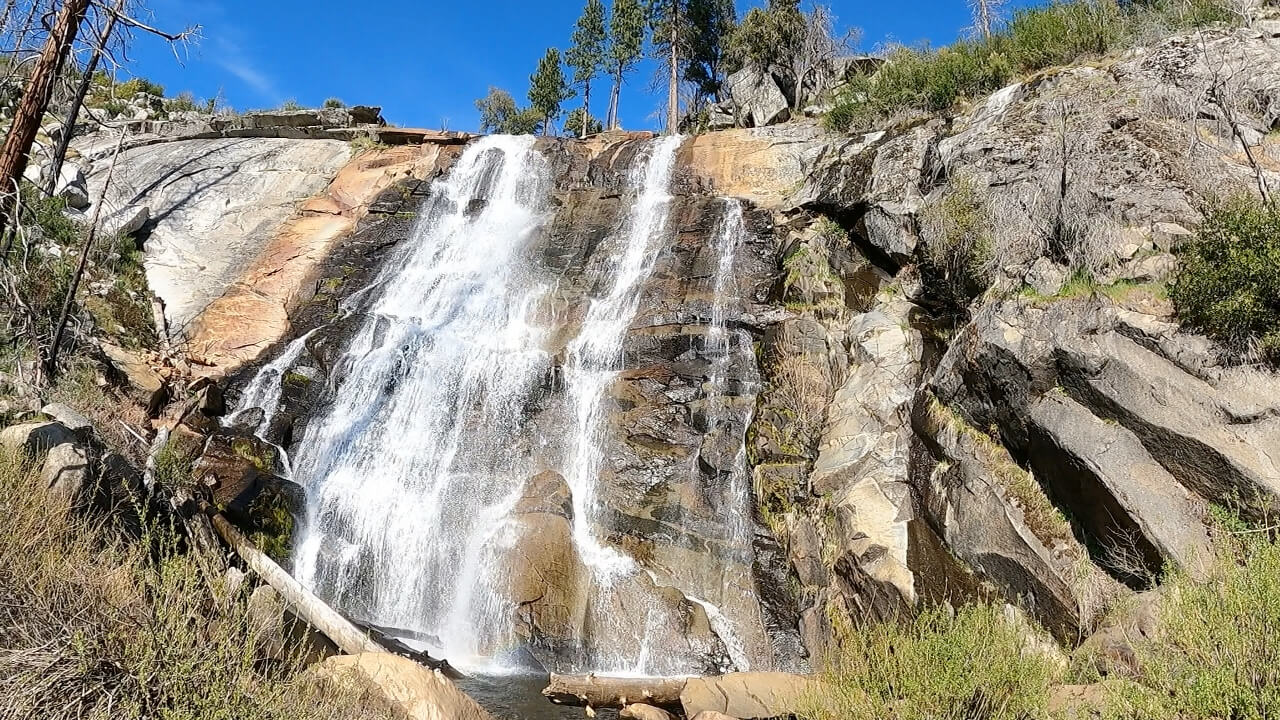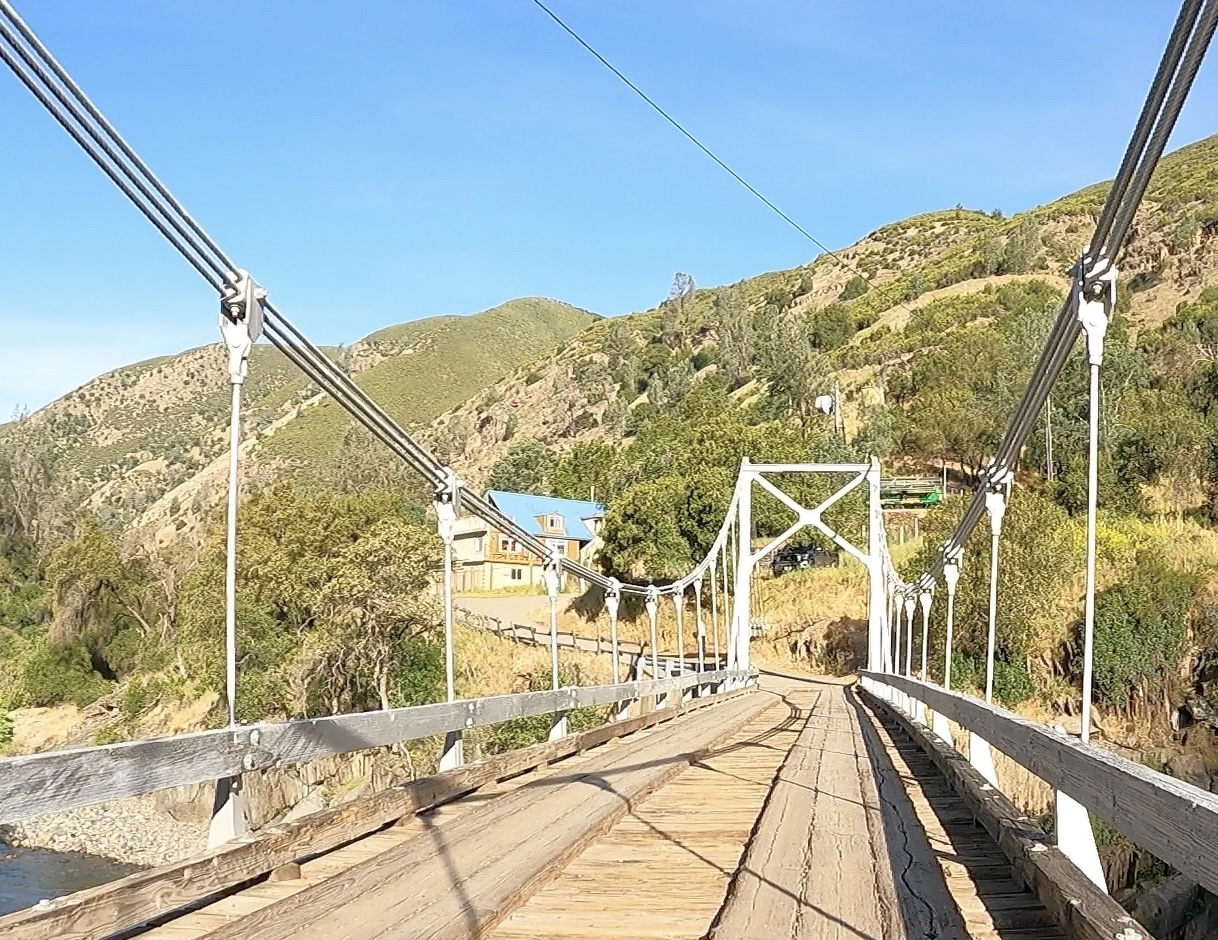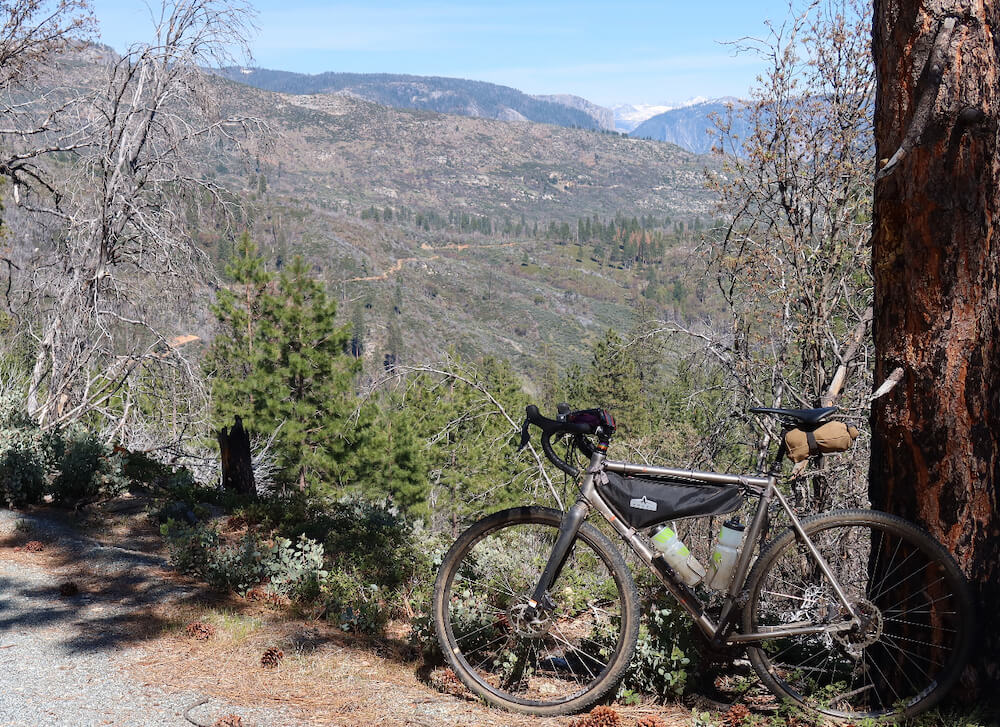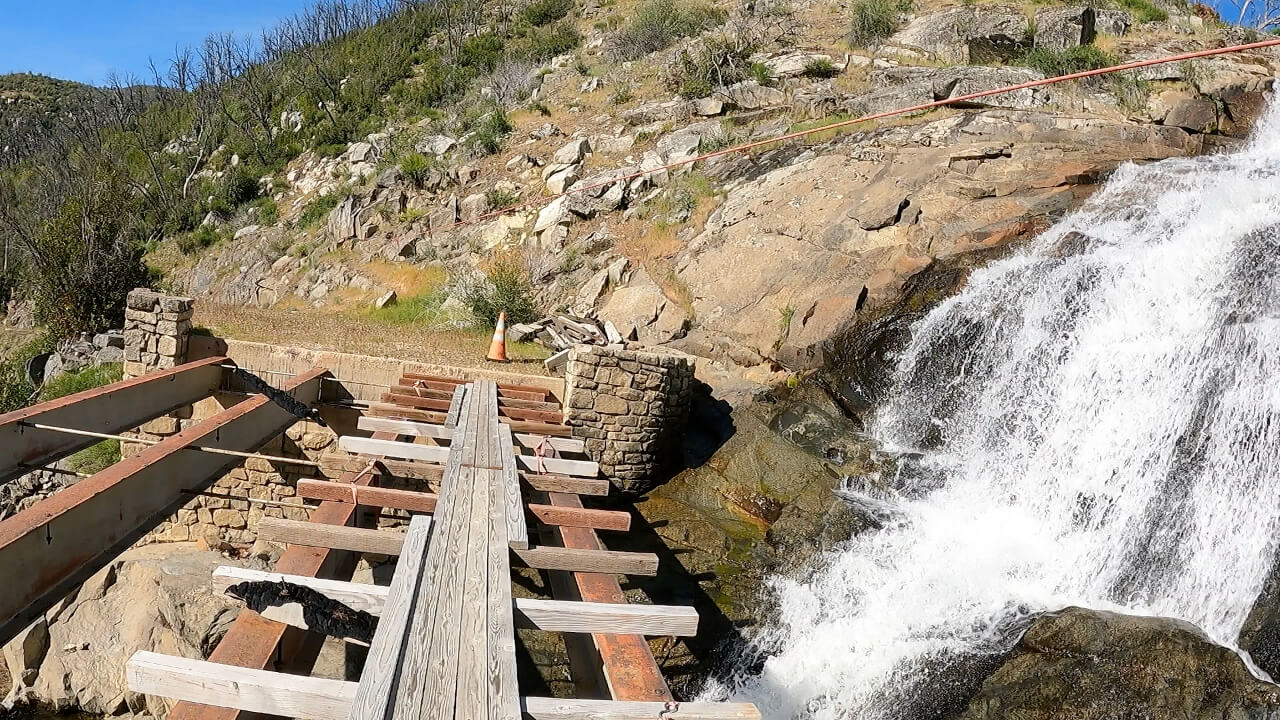Adventure Miles: People, place, and an unpaved road home to Yosemite
Yosemite. Majestic glacier-carved granite. Views for days. And on most roads, cars galore, tour buses, and recreational vehicles with “1-800-2RENTME” emblazoned across the back. The drivers, more focused on views than the road, can be frightening for a bicyclist. There’s an untrammeled road into the valley, however. One needs wider bike tires and the desire to work for it, though. The road less traveled is mostly dirt and climby. It also happened to be a road to my birthplace. Traversing a car-free road into Yosemite afforded me an opportunity to reflect upon people and place, birth and death, national parks and original peoples’ displacement. A little light reflection following a year of lockdown.
 First waterfall on the Foresta-El Portal descent.
First waterfall on the Foresta-El Portal descent.
The Coulterville-Yosemite Road was the first stagecoach route into Yosemite Valley. First to market does not guarantee success, however. Originally opened in 1874 as a toll road, the route ultimately lost out to the competing toll road to the north and the competing toll road to the south. Those toll roads in turn faltered when a railroad line punched its way up the Merced River grade. The northern and southern routes were taken over by the state and are, for the most part, today’s Highway 120 out of Groveland and Highway 41 out of Oakhurst. The Coulterville-Yosemite Road fell by the wayside, forgotten by most. It runs through county, US Forest Service, and National Park Service land. An old dirt road, through parts little traveled, with deep history.
Having been born in Yosemite with roots in the area going back four generations, you would think I’d be familiar with the road. But the first I had heard about it was by coming across it in a newspaper article years ago. Given an elevation range from 1,200′ to just over 5,400′, the route is snow-risky in winter and deathly hot in summer. I had an opening in late April, making an easterly detour on a trip down to Los Angeles. Time enough for a one-day loop. I duplicated the route the Chronicle author described, parking the rental car at the bottom of the Briceberg grade along the Merced River. I then climbed Burma Grade, headed north to the Old Coulterville-Yosemite Road, then east to Foresta, descended a decaying road 2,300′ to El Portal, and then sailed along the Merced River on the 140’s slight downgrade back to Briceberg. The last 16 miles travel along a two-lane highway with limited shoulder, but with a downgrade and generally civilized drivers, they don’t feel horribly exposed.
The most thorough research
Like many intrepid adventurers, particularly those traveling alone, I did what I mistakenly thought was thorough terrain research. More on that later. Using Strava’s segment explore feature, I located a relatively large group that had ridden the same route the previous June. One of the riders took tons of photos and provided a detailed write-up. This helped tremendously in understanding the terrain, including tire decisions and hydration. That group sustained numerous flats, with one rider on a road bike. I thought a solo rider, untethered from large group rides’ inherent cumulative delays, would be faster than the group’s 10.5-hour evolution. The mountains punished me for that hubris.
 Bridge at Briceburg across Merced River to Burma Grade.
Bridge at Briceburg across Merced River to Burma Grade.
I overnighted at the Yosemite Bug Rustic Mountain Resort, a funky hostel in Midpines. Welcoming, cheap, close to the start, and familiar. It was only a few miles from where my grandparents moved after retiring from working in Yosemite for the Yosemite Park and Curry Company. Waking early to avoid the forecasted 90-degree heat, I checked out, thinking I would finish the ride mid-afternoon and head straight for Los Angeles, my ultimate destination. I would instead find myself gratefully accepting another night at the Bug at the end of a very, very long day.
Going up
The ride began with a steep, steady dirt climb up the Merced River gorge’s north side from Briceberg. Burma Road switchbacks up the steep mountainside before punching into mountainous ranch land. As I moved away from the river and the gorge’s shadows, the temperature steadily climbed despite the early hour. Wildflowers dusted the roadside as the terrain gave way to eerily quiet ranches. A romping mild descent brought me to a short stretch of battered blacktop connecting a smattering of ranch houses to the Old Coulterville-Yosemite Road.
A little further on, the Briceberg/Burma Grade spur merged into the Old Coulterville-Yosemite Road. A hairpin right would take me up more steeps, back in the dirt, toward Yosemite. But first, I took a quarter-mile detour in the opposite direction, toward Coulterville. There, a plaque proudly calling the route the Coulterville Toll Road told the road’s history. Next to it, snaking up the hillside, a narrow footpath disappears. Up that way, past more than a smidge or two of poison oak, hides Bowers Cave. Originally called Oo-tin by the Miwok, it was repurposed by miners and stagecoach support services. At its height it held a dance floor reached initially by basket and later by stairs. An eight-room hotel offered respite for travelers and those who had too much fun at the regular Saturday night dances. A locked iron gate now prevents cave entry.
Turning around, it was time to climb in earnest again. Over the next 10 miles, the road climbed from 2,400′ to over 5,000′, and the morning heat kicked in. Well into the ride, and with the initial excitement of being out settled down, I took advantage of the steady climb to crawl deep into my head, contemplating people and place.
I’m going back to Valley
The route held more than just adventurer’s curiosity. It was a ride to native land that I barely know, with complex emotional overlays. I was born in Yosemite, my father a park concessionaire employee. He too was born in Yosemite, his parents also park concessionaire employees. My father’s recent death left me with questions about what I did not know about him and the land we came from. The backcountry time gave me an opportunity to parse relationships — familial, cultural, and geographic.
Our family’s history in the area dates back four generations to the 1860s, including a fellow with the wonderful name William Bluford “Boot” Taylor. Boot was an early Sierra National Forest ranger and rancher whose cabin now can be visited at the Fresno Flats Historic Park outside Oakhurst. Our four generations are a blip in time compared to the 8,000 years the Ahwahneechee resided in Yosemite, however.
Our family left the valley when I was a year old. The park concessionaire, the Yosemite Park and Curry Company, was acquired by Los Angeles-based MCA, an entertainment company that later became Universal Studios and is now folded into Comcast. With MCA came a decidedly possessive attitude toward the park, a false ownership arrogance that it was now their plaything. With that attitude, it became apparent that the land my father spent 31 of his first 35 years in was no longer welcoming. In the early portion of those 31 years, my father went to elementary school on the valley floor with the native Ahwahneechee, including a friend named Bill Tucker.
Most people see Yosemite as a park. To the first peoples, it was still home. My parents left Yosemite by choice. The Ahwahneechee did not. The last Yosemite Valley Ahwahneechee was pushed out decades ago. In the not-too-distant past, my cousin, who also grew up in Yosemite, was appointed Park Superintendent. At one point, he received a visit from that same elementary school friend of my father, Bill Tucker. Tucker, nearing 80, bore an old photo of my father and Tucker together. The Ahwahneechee have long pressed for a return to the land that was taken from them. The elder’s relationship to my father, and through my father’s sister to her Yosemite-raised, now Park Superintendent son, framed a discussion about the powerful connection between people and place.
The Park Service and the Elders reached an agreement for the Ahwahneechee to construct and use a wahhoga, the Miwok word for village, on the valley floor. A small action that does not balance the centuries-long genocide and displacement of indigenous people by the federal government. But a tiny step forward instead of another step back.
Upward
The deep dive into relationships distracted me from the steady continuous climbing, making the time pass quickly. It was on this stretch that I encountered the few vehicles I saw on everything but the Highway 140 stretch. A county road crew passed me on the climb. I came across them later, working on downed trees. They posed the usual questions: “Where are you going?” “Where are you coming from?” These were followed by stoic nods and water offerings. In what I should have recognized as foreshadowing, their team cleared downed trees. I thanked them for letting me through and kept grinding along.
Grinding was an accurate description. My hand ached and I felt unusually weak. The day before, momentary distraction led to a mistimed curb hop. I had gone over the bars and found myself on the ground, laughing at the silliness and aching from the impact. The hand throbbed at higher speeds on the bumps. I would later come to find out I had a small hand fracture, more evident once the swelling went down. As the road passed over a creek, I took the opportunity to fill bottles, sterilizing them with a Steri-Pen, and downed a few ibuprofen.
Lost in the trees
The climbing flattened out a little over 5,000′. The road bit into the mountainside, serpentining in and out of steep chutes. This spectacular terrain was marked with the beginnings of granite. I began to hit my stride. With the challenging climbs behind me, I thought the rest would be relatively easy.
A little routing explanation: The official Old Coulterville-Yosemite Road splits to the left at a five-way intersection, heading northeast before ending at the Merced Grove at Highway 120. This is a good connector if one plans to tackle the Tioga Pass Road to the East Side. The 120 will also take one into Yosemite Valley. That’s not a terrible way to go but there’s more road exposure with cars and RVs, their drivers frequently overwhelmed by their first views of the Valley.
 Astounding vistas amidst downed trees.
Astounding vistas amidst downed trees.
To stay on the dirt, one shifts from the Old Coulterville-Yosemite Road onto Forest Road 1S12. As I rounded a corner along Forest Road 1S12, the route seemed to disappear behind several downed trees. Easy became uneasy. I clambered over the five downed trees. As I lowered my bike down on the far side, I saw more downed trees ahead. And so it began. Ride a little, clamber a lot. Many of the trees were charred, burned in the 2013 Rim Fire. I would later remember that a January windstorm, so severe it earned the name Mono Wind Event, closed Yosemite for weeks early in the year. The wind blasted down trees, and this area had not yet been cleared.
The downed tree issue was notably absent from my route research. I knew I was roughly four miles from Foresta, where there would be an easy out. I continued forward. Those four miles took roughly four hours. There are frequently moments on epic rides that test one’s mettle. This tested mine. The section had its moments, like when I startled a bear and it crashed into the underbrush. Not a great place to be dancing with a bear, given I was progressing at an average of one mile an hour. The best moment was reaching Little Nellie Falls, crossing the creek, and putting the downed tree challenges behind me.
Bridge out ahead
A brutal but short climb from Little Nellie Falls was marked by a formal sign marking the Yosemite National Park boundary. Shortly after that the roads transformed into manicured gravel, maintained by Foresta’s residents. Foresta is a rare private home inholding within the national park itself. The plateau has a view up the valley. I took an obligatory selfie with Half Dome in the background, looking somewhat worse for wear.
One can climb the Foresta road to the 120 and then use the road to drop into the valley. If the Yosemite Valley is the ultimate destination, this is a direct valley route. The descent makes the vehicles palatable, and the tunnels and views are energizing. This will also quickly connect one to the 140 and back down the Merced gorge if one happens to be done with dirt for the day.
The alternative is the old Foresta-El Portal road. Despite all the “Bridge out!” warnings, the route is passable on foot or bike. It is, however, no longer a road. It is single-track that descends roughly 2,300′ over six miles, with several dismounts along the way. It is also overgrown, with a touch of poison oak. The single track and bridge crossings are worth the risk, though, particularly if one has a poison oak remover like Tecnu back at the car.
 Mind your step crossing the Foresta-El Portal descent’s second bridge.
Mind your step crossing the Foresta-El Portal descent’s second bridge.
This being an adventure, I picked the Foresta-El Portal single track instead of the paved road. I bumped down the trail. As I nervously glanced left and right for poison oak, I nearly ran over a gopher snake. A good reminder to pay attention. Gopher snakes are not the only mountain reptiles. The encounter reminded me of a story my father told me. At the end of a long day fishing a known rattlesnake area, he said to his father, my grandfather, “We didn’t see any rattlesnakes today, Dad!” Without missing a beat, my grandfather replied, “Yes, but how many saw us?”
By the time I arrived in El Portal, my bottles were drained, my body battered. The Park Service employees now live in El Portal, out of the valley proper. A few rangers were milling about in front of an administration building with a hose bib. They let me refill my bottles with sufficient water for the remaining road push.
Train hard
As I left El Portal, I passed a plaque, an old steam locomotive, and a few railcars sitting on rail remnants. This was the remains from the rail connection that used to bring travelers up the Merced River grade. The railbed, now sans tracks, runs along the north side of the river. There has been some discussion about turning this into a multi-use path, potentially extending all the way down to Snelling or Merced, to improve bike access to Yosemite. I fear it will remain a discussion only, however, given the cost.
I turned onto the 140. Traffic was light and the drivers polite, giving me wide berth. The highway is not narrow but lacks a significant shoulder. There was a slight headwind coming up the river. Despite the wind, I made good time along the 16 road miles back to the car with the mild riverbed downgrade. The sun was getting low, sometimes shining in my eyes but mostly hidden behind the high gorge walls. A steady state push on smooth roadway was all that remained. As I rounded the final turn before Briceberg, the suspension bridge to Burma Grade came into view, where nearly 11 hours earlier I had started the journey.
I pulled up to the rental car, switched into flip flops, wiped my arms and legs down with Tecnu, and limped down to the river. Immersing myself in the water felt ceremonial. Baptized in the snow-melt waters, I rinsed off salt, grit, and emotional crust. Had I found answers about place and people, about my father and how we all relate? Hardly. But the journey provided another opportunity to dig at the issues, and time to fill in physical unknowns, turning map lines into sensorial experiences.
The Rustic Bug Mountain Resort fortunately had space for me again that night. I say fortunately because it took all my remaining energy to drive myself there, force some food into my stomach, and crawl into the tent cabin bed. Some travels exhilarate, some entertain, and some provide humble reflection. This had it all, with a healthy dose of the latter.
Considering the route?
Have you or someone you know been involved in a bicycle crash? Curious about your rights? Are you a lawyer handling a bicycle crash who wants more information on how to get the best result for your client? Contact Bicycle Law at (866) 835-6529 or info@bicyclelaw.com.
Bicycle Law’s Bob Mionske is licensed to practice in Oregon, its affiliate Coopers LLP has lawyers licensed in California, and either can affiliate with local counsel on bicycle cases across the country to make sure cyclists get the benefit of lawyers who focus on the issues specific to bicycle incidents.
Archives
Considering the route?
Weather: The county keeps county roads clear starting May 1. Heat is the killer, so late spring or early fall are best. Water refills can get dicey in the fall. Given the portions over 5,000′, winter is not advised.
